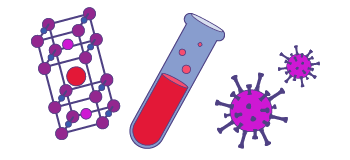AC magnetic susceptibility measures magnetic moment of a sample which is exposed to an oscillating external magnetic field.
Two coil sets are used to measure the AC magnetic susceptibility, one to apply the oscillating magnetic field (primary or excitation coil) and the other to measure the induced voltage (secondary or pick-up (sensing) coil). The induced voltage is proportional to the change of the time varying magnetic moment (Faraday’s law) and the AC magnetic field frequency and amplitude (typically 1 Hz ~ 1 kHz and 0.1 ~ 10 Oe). The AC magnetic susceptibility can be used as a complimentary method to DC magnetic measurement techniques and also to study magnetic relaxation.
Resistive Magnets
Superconducting Magnets
Hybrid Magnet

Explore our magnet schedule to see what exciting research is happening on our stellar fleet of instruments right now.
Dun, et al, Magnetic ground states of the rare-earth tripod kagome lattice Mg2RE3Sb3O14 (RE = Gd, Dy, Er), Phys. Rev. Lett (editor's suggestion), 116 (2016) Read online.
Wang, et al, Low temperature, high magnetic field investigations of the nature of magnetism in the molecular semiconductor β- cobalt phthalocyanine (C32H16CoN8), J. Mag. Mag. Mater., 407 (2016) Read online.
Nikolo, et al, Inter and intra granular flux pinning dynamics in Ba(Fe0.91Co0.09)2As2 superconductor, J. Low Temp. Phys., 178 (2015) Read online.
Dun, et al, Competition between the inter- and intra-sublattice interactions in Yb2V2O7, Physical Review B, 91 (2015) Read online.
Dun,et al, Antiferromagnetic order in the pyrochlores R2Ge2O7 (R=Er, Yb), Phys. Rev. B, 92 (2015) Read online.
Thompson, et al, Unconventional magnetism in ThCr2Si2-type phosphides, La1-xNdxCo2P2, J. Mater. Chem. C, 7561 (2014) Read online.
Lee,et al, Series of phase transitions and multiferroicity in the quasi-two-dimensional spin-1/2 triangular lattice antiferromagnet Ba3CoNb2O9, Physical Review B, 89 (2014) Read online.
Lee, et al, Magnetic phase diagram and multiferroicity of Ba3MnNb2O9: A spin-(5/2) triangular lattice antiferromagnet with weak easy-axis anisotropy, Phys. Rev. B, 90 (2014) Read online.
Hallas, et al, Incipient Ferromagnetism in Tb2Ge2O7: Application of Chemical Pressure to the Enigmatic Spin-Liquid Compound Tb2Ti2O7, Physical Review Letters, 113 (2014) Read online.
Dun, et al, Chemical pressure effects on magnetism in the quantum spin liquid candidates Yb2X2O7 (X=Sn, Ti, Ge), Physical Review B, 89 (2014) Read online.
Dun, et al, Yb2Sn2O7: approaching a quantum critical point from the ferromagnetic side, Physical Review B, 87 (2013) Read online.
Hwang, et al, Successive Magnetic Phase Transitions and Multiferroicity in the Spin-One Triangular-Lattice Antiferromagnet Ba3NiNb2O9, Physical Review Letters, 109 (2012) Read online.
Hallas, et al, Statics and dynamics of the highly correlated spin ice Ho2Ge2O7, Physical Review B, 86 (2012) Read online.
Rall, et al, Metamagnetism and nanosize effects in the magnetic properties of the quasi-two-dimensional system beta -Ni(OH)2, Physical Review B, 82 (2010) Read online.
J. Hwang, et al, Magnetic Phase Transitions and Multiferroicity in Quasi-two-dimensional Spin-1/2 Triangular Lattice Antiferromagnet Ba3CoNb2O9, (2012) Read online.
L. Yin, et al, Magnetic Susceptibility of the Pyrochlore Magnet Tb2Ti2O7 at High Fields, (2012) Read online.
Last modified on 13 December 2023